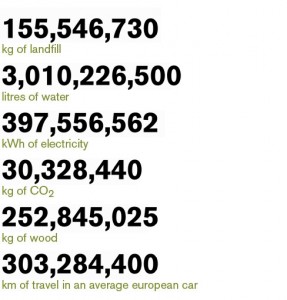2012 Arjowiggins Graphic Environmental Benefit Statement Totals

We’re keeping a running total of the reduction in environmental impact that Arjowiggins Graphic recycled papers have made since January 2010. Since January 2010, by using Arjowiggins Graphic recycled papers in the UK the environmental impact was reduced by:

Source: Carbon footprint data evaluated by FactorX in accordance with the Bilan Carbone® methodology. Calculations are based on a comparison between the recycled paper used versus a virgin fibre paper according to the latest European BREF data (virgin fibre paper) available.
Want your own version?
Creating your EBS is easy. Just follow these simple steps:
Submit the details of your print job into the ‘E-Calculator’
- Wait for the results and create a PDF (or if you prefer you can just use these statistics as text format in your own artwork)
- Send the results to us using the link on the site (attach to email)
- We’ll send you your official EBS.
A number of tweets were posted on the Ajrowiggins Graphic Twitter feed ( @Arjowiggins ) putting the totals in perspective:
- Since January 2010, by using Arjowiggins Graphic recycled papers in the UK the environmental impact was reduced by 155,546,730 kg of landfill
- A nice tenuous one to start with – that reduction in landfill is the equivalent weight of Brasil’s annual Cocoa bean production!
- The landfill saving is also the equivalent to 129,167 cubic meters of landfill (based on 1.2 tonnes per cubic meter)!
- Since January 2010, by using Arjowiggins Graphic recycled papers in the UK the environmental impact was reduced by 3,010,226,500 litres water
- That’s 662,156,986 gallons water saved since 2010!
- The saving in water is more than 105 times the capacity of the world’s largest aquarium; Georgia Aquarium!
- If you added up all the water in the top 10 largest aquariums in the world it would still be less than 3% of the water that we have saved*!
- *Manufacturing recycled papers as opposed to virgin fibre paper
- The amount of water saved is also the equivalent to 1,204 Olympic sized swimming pools!
- Last one of the day – the amount of water we have saved since 2010 is also over 61 times the amount of water displaced by the QE2!
- Since January 2010 by using Arjowiggins Graphic recycled papers in the UK the environmental impact was reduced by397,556,562 kWh electricity
- The electricity saved would be enough to run 82,824 average UK households for a year!
- The energy saving we have made in the UK is the equivalent to lighting 1 million 60 watt light bulbs for just under 40 weeks
- Or 1,000 lightbulbs for 756 years
- That is also the equivalent to running 1,000 standard desktop computers for 303 years – although you may have needed a new one by then!
- Since January 2010 by using Arjowiggins Graphic recycled papers in the UK the environmental impact was reduced by 30,328,440 kg of CO2
- That’s 30,328 tonnes of CO2 and greenhouse gases!
- A bit more info on our CO2 saving: 1 tonne (CO2) contains 22,730 moles of CO2 and occupies 556.2 m3 volume.
- So by those calculations that means we have saved 689.365 Million moles of CO2 by using recycled paper rather than virgin fibre paper!
- That is also the equivalent to 16,868,433.6 m3 volume!
- The amount of CO2 we have saved since 2010 could fill 84 Hindenburg blimps
- However, it could never take off as CO2 is 22 times denser than Hydrogen and 11 times denser than Helium!
- Since January 2010 by using Arjowiggins Graphic recycled papers the UK the environmental impact was reduced by 252,845,025 kg of wood
- The amount of wood we have saved is the equivalent to the weight of 5.5 Titanics or 25 Eiffel Towers!
- Since January 2010 by using Arjowiggins Graphic recycled papers the UK the environmental impact was reduced by 303,284,400 km travel (car)
- That is – equivalent travel in an average european car!
- That distance is the equivalent to driving Route 66 a staggering 33,698 times!
- So if you were to drive that in one go, averaging 70mph it would take you 308 days || or 2,692,174 hours
- The distance is the same as the distance to Mars and back twice, then back to Mars and then halfway back to Earth (in an average EU car)
- That is of course if you could drive to Mars and that is when Mars is at it’s closest (it gets 54.6 million km away from us) #tenuous?